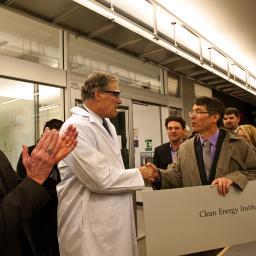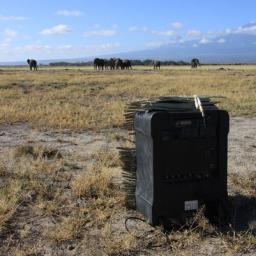A recent
Nature Podcast (
Radio Signals
) features a new type of optical amplifier which converts faint radio signals
directly into laser light . The novel approach shows promise with greatly reduced noise and improved sensitivity.
Radio waves are used for many measurements and applications, for example, in communication with mobile phones, MRI scans, scientific experiments and cosmic observations. But 'noise' in the detector of the measuring instrument limits how sensitive and precise the measurements can be. Now researchers at the Niels Bohr Institute have developed a new method where they can avoid noise by means of laser light and can therefore achieve extreme precision of measurements.
We have developed a detector that does not need to be cooled down, but which can operate at room temperature and yet hardly has any thermal noise. The only noise that fundamentally remains is so-called quantum noise, which is the minimal fluctuations of the laser light itself. ... This membrane is an extremely good oscillator and that is why it is so ultrasensitive. At room temperature, it works as effectively as if it was cooled down to minus 271 C and we are working to get it even closer to minus 273 degrees C, which is the absolute minimum. In addition, it is a huge advantage to use optical detection, as instead of using ordinary copper wires to transmit the signal, you can use fiber optic cables, where there is no energy loss,
explains Eugene Polzik, Professor and Head of the research center Quantop at the Niels Bohr Institute at the University of Copenhagen.
Could this be the start of a new era of ultra-sensitive devices, or low-cost/high energy technology?
A team of Harvard researchers showed that the commonly found bacterium Rhodopseudomonas palustris can use
natural conductivity to pull electrons from minerals located remotely in soil and sediment while remaining at the surface, where they absorb the sunlight needed to produce energy.
Led by Peter Girguis, a team of researchers showed that the commonly found bacterium Rhodopseudomonas palustris can use natural conductivity to pull electrons from minerals located deep in soil and sediment while remaining at the surface, where they absorb the sunlight needed to produce energy.
"When you think about electricity and living organisms, most people default to Mary Shelley's Frankenstein, but we've long understood that all organisms actually use electrons - what constitutes electricity - to do work," Girguis said. "At the heart of this paper is a process called extracellular electron transfer (EET), which involves moving electrons in and out of cells. What we were able to show is that these microbes take up electricity, which goes into their central metabolism, and we were able to describe some of the systems that are involved in that process."

Dicephalic parapagus twins, or a single body with two heads, were
born in India on March 12th. India.com reports
"the twins have a slim chance of survival even after they are operated upon" and the parents have yet to name their conjoined daughters. [It] may not be possible to separate the twins because they share the same body. "The baby girl has two heads, two necks and two spines, but only one body, one lung for each head, two separate oesophaguses and trachea, a single stomach and heart. Most of the vital organs are shared," said Dr Amit Gupta, medical director of Sonepat's Cygnus JK Hindu Hospital, where the conjoined twins were born.
The parents are poor and did not have an ultrasound until the last trimester.
"It was on February 24 that the patient came to meet me and was into her 8th month of pregnancy. The mother had not gone through any tests earlier as she couldn't afford an ultrasound test. And it was then we broke the news to the family that there are conjoined twins to be born, and that their babies hadn't completely separated" gynaecologist Dr Shikha Malik said.
While having a single set of organs for conjoined twins does put more strain on the body, there are examples of thriving dicephalic parapagus twins, such as
Abby and Brittany Hensel. The pair, now age 24, had a reality show on US TV channel TLC in 2012.

Across the country, math geeks in museums, schools, private groups and elsewhere gather to
celebrate the number pi, approximately 3.14. That's why March 14 -- 3-14 -- is
Pi Day. What's more, Albert Einstein was born on this day.
Throughout history, people have been captivated by this number because there is no way to calculate it exactly by a simple division on your calculator. What's more, its digits go on infinitely, without any pattern in the numbers. 3.1415926535897932 ... etc. Even that many digits are more than most people would need for everyday use, but some folks have been inspired to memorize thousands of digits of pi, or even use the digits to create poetry or music.
If you want to go where the day is said to be "invented," look no further than
San Francisco's Exploratorium. Larry Shaw, who worked in the electronics group at the museum, began the tradition in 1988. Last year was Pi Day's 25th anniversary there.

A
recent study [Elsevier - paywalled] revealed that preschool-age children are better at figuring out how to use technological gadgets than college students.
CBS News is reporting that researchers at the University of California, Berkeley, tasked 106 children between the ages of 4 and 5 and 170 college students with figuring out how to use a gadget with which they had no prior experience.
The gadget worked by placing different clay shapes in special boxes to determine which combination would cause a box to light up and play music.
Ultimately, the younger children were reportedly much faster at figuring out the correct combination.

Scientists from the
University of Washington have built the thinnest-known LED that can be used as a source of light energy in electronics. Most consumer electronics use three-dimensional LEDs, but these are 10 to 20 times thicker than the LEDs being developed by the UW.
The UW's LED is made from flat sheets of the molecular semiconductor known as tungsten diselenide, a member of a group of two-dimensional materials that have been recently identified as the thinnest-known semiconductors. Researchers use regular adhesive tape to extract a single sheet of this material from thick, layered pieces in a method inspired by the 2010 Nobel Prize in Physics awarded to the University of Manchester for isolating one-atom-thick flakes of carbon, called graphene, from a piece of graphite.
In addition to light-emitting applications, this technology could open doors for using light as interconnects to run nano-scale computer chips instead of standard devices that operate off the movement of electrons, or electricity. The latter process creates a lot of heat and wastes power, whereas sending light through a chip to achieve the same purpose would be highly efficient.

The Los Angeles Times reports
elephants distinguish human voices by sex, age, ethnicity according to a new study.
USA Today notes
Maasai men, who may hunt the elephants, were treated differently than Kamba men, who are farmers. When the voice belonged to a Maasai man, the elephants tended to sniff the air and bunch closely together for protection. But when the voice was a Kamba man's, the elephants were more nonchalant. The elephants also reacted with relative calm to the voices of Maasai women and boys, who, unlike Maasai men, generally don't take part in spearing elephants.
Voice of America says the study is available now but does not appear posted on the Proceedings of the National Academy of Sciences site yet.
When I first started studying bioinformatics almost fifteen years ago (!) what drew me to the field was the promise that we might soon be able to provide effective, personalized treatments for a wide variety of diseases. There have been some successes along the way, like
genetic tests for warfarin dosage, but for the most part our gains in understanding of basic biology haven't been matched by clinical advances. Now it looks like
that's finally about to change, and it's about time.
Too many people suffer and die from too many diseases that we more or less understand, but can't effectively treat. I hated it when I worked in hands-on patient care, and I hate it now in the lab. We are, finally, getting there.

Pharmaceutical company Zogenix has received US
FDA approval to launch a new hydrocodone-based analgesic in March. The drug is intended only for chronic pain, not as an short term or as-needed analgesic. CNN is reporting
a coalition of groups are lobbying for the FDA to revoke their approval before the medicine is even available. The concerns echoed by all groups are broadly about the drug's potency and abuse potential. They say they fear that Zohydro -- especially at higher doses -- will amplify already-rising overdose numbers. "You're talking about a drug that's somewhere in the neighborhood of five times more potent than what we're dealing with now," said Dr. Stephen Anderson, a Washington emergency room physician who is not part of the most recent petition to the FDA about the drug. "I'm five times more concerned, solely based on potency." A number of other news outlets are hyping the potency of Zohydro, going so far as
calling the drug ten times more powerful than a 5mg Vicodan. A fairer comparison may be to OxyCodone, since they have similar opioid levels.
Zohydro ER will be available in 10 mg, 15 mg, 20 mg, 30 mg, 40 mg, and 50 mg strengths. Chemistry Pipedotters can find the structural formula for hydrocodone bitartrate on RxList. Should the FDA allow such a potent medication on the market? Or would
moving opioid analgesics to Schedule II mitigate the potential for abuse?
Last year, researchers at The University of Nottingham discovered
a new layer in the human cornea. The
latest research from the team shows this new layer, called Dua's Layer, makes an important contribution to the sieve-like meshwork in the periphery of the cornea. Defective drainage in this area is an important cause of glaucoma; a condition that affects 1% to 2% of the world's population.
Professor Dua said: "Many surgeons who perform lamellar corneal transplant recognise this layer as an important part of the surgical anatomy of the cornea. This new finding resulting from a study of the microanatomy of the periphery of the layer could have significance beyond corneal surgery."





